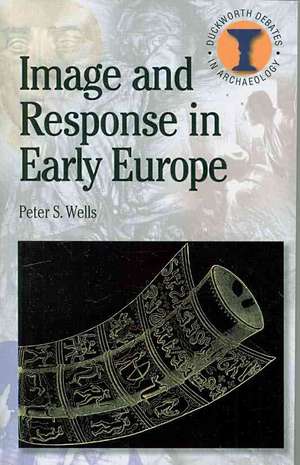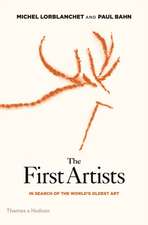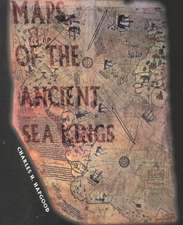Image and Response in Early Europe: Debates in Archaeology
Autor Peter S. Wellsen Limba Engleză Paperback – 28 mai 2008
Din seria Debates in Archaeology
- 24%
 Preț: 170.07 lei
Preț: 170.07 lei - 24%
 Preț: 170.50 lei
Preț: 170.50 lei - 28%
 Preț: 466.81 lei
Preț: 466.81 lei - 14%
 Preț: 164.50 lei
Preț: 164.50 lei - 17%
 Preț: 171.76 lei
Preț: 171.76 lei - 17%
 Preț: 169.62 lei
Preț: 169.62 lei - 13%
 Preț: 248.61 lei
Preț: 248.61 lei - 18%
 Preț: 169.08 lei
Preț: 169.08 lei - 14%
 Preț: 163.42 lei
Preț: 163.42 lei - 30%
 Preț: 566.67 lei
Preț: 566.67 lei - 22%
 Preț: 594.35 lei
Preț: 594.35 lei - 24%
 Preț: 169.27 lei
Preț: 169.27 lei - 14%
 Preț: 169.27 lei
Preț: 169.27 lei - 24%
 Preț: 169.62 lei
Preț: 169.62 lei - 14%
 Preț: 170.69 lei
Preț: 170.69 lei - 13%
 Preț: 247.98 lei
Preț: 247.98 lei - 24%
 Preț: 168.74 lei
Preț: 168.74 lei - 24%
 Preț: 169.62 lei
Preț: 169.62 lei - 14%
 Preț: 247.22 lei
Preț: 247.22 lei - 18%
 Preț: 253.64 lei
Preț: 253.64 lei - 18%
 Preț: 169.44 lei
Preț: 169.44 lei - 14%
 Preț: 178.22 lei
Preț: 178.22 lei - 13%
 Preț: 247.98 lei
Preț: 247.98 lei - 17%
 Preț: 170.32 lei
Preț: 170.32 lei - 17%
 Preț: 170.07 lei
Preț: 170.07 lei - 17%
 Preț: 169.71 lei
Preț: 169.71 lei - 13%
 Preț: 149.87 lei
Preț: 149.87 lei - 14%
 Preț: 162.79 lei
Preț: 162.79 lei - 24%
 Preț: 169.71 lei
Preț: 169.71 lei - 14%
 Preț: 169.88 lei
Preț: 169.88 lei - 24%
 Preț: 170.07 lei
Preț: 170.07 lei - 24%
 Preț: 170.07 lei
Preț: 170.07 lei -
 Preț: 169.62 lei
Preț: 169.62 lei - 14%
 Preț: 169.62 lei
Preț: 169.62 lei - 14%
 Preț: 169.88 lei
Preț: 169.88 lei - 13%
 Preț: 149.87 lei
Preț: 149.87 lei - 30%
 Preț: 567.99 lei
Preț: 567.99 lei - 14%
 Preț: 170.32 lei
Preț: 170.32 lei - 23%
 Preț: 248.17 lei
Preț: 248.17 lei - 17%
 Preț: 169.71 lei
Preț: 169.71 lei - 30%
 Preț: 537.55 lei
Preț: 537.55 lei - 18%
 Preț: 169.27 lei
Preț: 169.27 lei - 13%
 Preț: 247.70 lei
Preț: 247.70 lei
Preț: 169.79 lei
Preț vechi: 198.14 lei
-14% Nou
Puncte Express: 255
Preț estimativ în valută:
32.49€ • 34.74$ • 27.09£
32.49€ • 34.74$ • 27.09£
Carte tipărită la comandă
Livrare economică 18 aprilie-02 mai
Preluare comenzi: 021 569.72.76
Specificații
ISBN-13: 9780715636824
ISBN-10: 0715636820
Pagini: 208
Dimensiuni: 135 x 216 x 13 mm
Greutate: 0.21 kg
Ediția:New.
Editura: Bloomsbury Publishing
Colecția Bristol Classical Press
Seria Debates in Archaeology
Locul publicării:London, United Kingdom
ISBN-10: 0715636820
Pagini: 208
Dimensiuni: 135 x 216 x 13 mm
Greutate: 0.21 kg
Ediția:New.
Editura: Bloomsbury Publishing
Colecția Bristol Classical Press
Seria Debates in Archaeology
Locul publicării:London, United Kingdom
Notă biografică
Peter S. Wells is Professor of Anthropology at the University of Minnesota. His recent works include The Battle that Stopped Rome (2003) and Beyond Celts, Germans and Scythians (2001; also in this series).
Descriere
Examines the visual aspects of the archaeological evidence to investigate the role that visuality - the visual quality of things - played in the expression of the self, in interaction between members of social groups, in ritual activity, and in the creation and experience of cultural landscapes.












